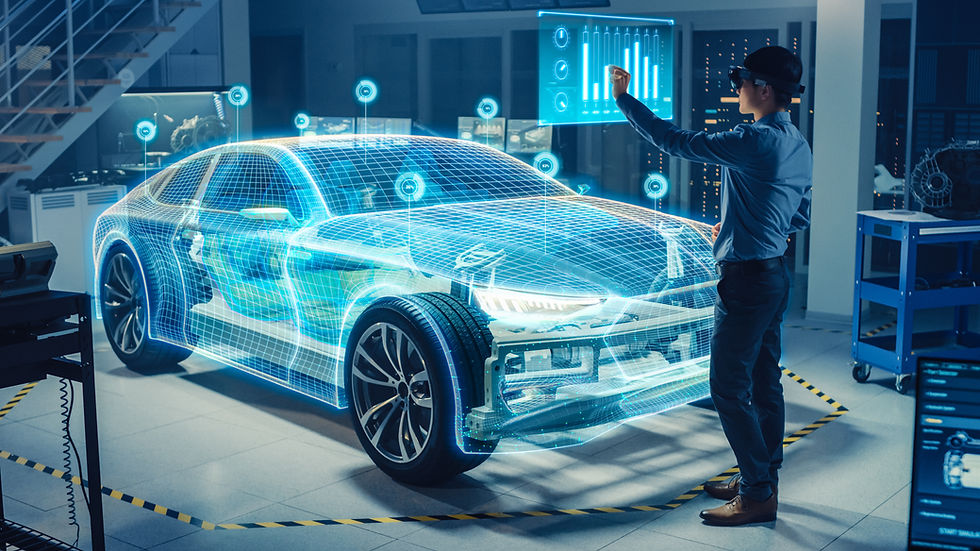AR vs. VR: Choosing the Right Immersive Technology for Your Business
- scalerrs
- Dec 8, 2023
- 6 min read
In the ever-evolving landscape of immersive technologies, Augmented Reality (AR) and Virtual Reality (VR) stand out as transformative forces. These technologies have the power to reshape how businesses engage with customers, design products, and streamline operations. In this comprehensive guide, we'll explore the differences between AR and VR, providing insights into when each technology is most effective for businesses.
Understanding Augmented Reality (AR)
What is AR?
Augmented Reality enhances the real world by overlaying digital information onto it. Unlike VR, AR does not immerse users in a completely virtual environment; instead, it supplements their real-world experiences with additional, often interactive, elements.
When to Choose AR for Your Business
Enhancing Real-world Experiences
NielsenIQ's comprehensive study reveals a significant consumer sentiment – 56% of shoppers express that AR instills confidence in the quality of a product. This statistic underscores the profound impact AR has on consumer perceptions.
Let's delve into the world of furniture retailing, where IKEA has ingeniously utilized AR to revolutionize how customers interact with their products. The IKEA Place app, a beacon of AR innovation, enables users to virtually position furniture items in their own living spaces through the lens of their smartphones. This translates into more than just a novel experience; it becomes a tool for informed decision-making. Potential buyers can see how a new sofa or coffee table seamlessly integrates into their existing decor, eliminating the guesswork that often accompanies online furniture shopping.
Imagine virtually placing that sleek bookshelf against your living room wall or visualizing how a cozy armchair complements your bedroom – all before making a purchase. This not only boosts customer confidence in their choices but, practically, it significantly reduces the likelihood of post-purchase disappointment. Customers are empowered to make decisions grounded in a tangible visualization of the end result, marking a paradigm shift in the traditional online shopping experience.
In essence, AR's role in enhancing real-world experiences extends beyond mere visualizations; it empowers consumers with a virtual window into the future, where products seamlessly integrate into their lives with confidence and certainty.
Facilitating Product Sampling
Delving into the world of cosmetics, industry giants like L’Oréal and Sephora have seamlessly integrated AR into their customer experience strategies. The concept is simple yet revolutionary – allowing customers to virtually try on makeup products. This transcends the limitations of physical product testers and provides a dynamic platform for customers to explore a myriad of cosmetic options.
Consider the scenario: a customer, armed with a smartphone, contemplates purchasing a new shade of lipstick. Instead of the traditional approach involving physical product testers, they opt for the AR experience. Through the magic of augmented reality, they virtually apply different shades, exploring the nuances and intricacies of each product without physically applying a single stroke. The result? A customer who not only spends more time engaging with the products but also ventures into sampling a broader range than they might in a traditional setting.
The beauty of AR in product sampling lies in its ability to make the process not just efficient but enjoyable. It transforms the act of sampling from a routine task to an interactive experience, where customers can experiment with different products, shades, and brands. This shift in dynamics is not only beneficial for customers, who get a more comprehensive understanding of available products, but it also opens new avenues for retailers to showcase their diverse product lines effectively.
In essence, AR in product sampling serves as a catalyst for exploration and engagement, amplifying customer interactions and, crucially, influencing purchase decisions in a retail landscape that thrives on immersive and personalized experiences.
Supporting Informed Decision-Making
Imagine a customer navigating the aisles of a home improvement store, armed with a smartphone equipped with an AR-powered app. In this scenario, retail giant Lowe’s stands out as a pioneer in leveraging AR to enrich the customer's shopping journey. Lowe’s in-store navigation app seamlessly integrates AR to provide users with real-time guidance, overlaying directional signals onto a live view of the store's layout. This not only aids customers in locating desired products efficiently but also enhances their overall in-store experience.
Consider a customer embarking on a quest to find the perfect lighting fixtures for their living room. Traditionally, they might consult a store map or seek assistance from staff. However, with Lowe’s AR-powered app, the customer can simply follow virtual cues that guide them to the precise aisle housing the desired products. Along the way, the app may alert them to ongoing promotions or provide additional information about featured products.
In this context, AR becomes more than just a technological feature; it transforms into a virtual assistant, offering personalized guidance and enriching the customer's journey. The result is a seamless blend of the physical and digital realms, where customers feel empowered with information and retailers enhance their engagement strategies to create a shopping experience that transcends the ordinary.
AR's role in supporting informed decision-making isn't confined to a specific industry; it's a versatile tool that can be tailored to meet the unique needs of diverse businesses, contributing significantly to customer satisfaction and, ultimately, fostering brand loyalty.
Unpacking Virtual Reality (VR)
What is VR?
Virtual Reality, on the other hand, immerses users in a simulated environment, entirely detached from the real world. VR often requires specialized hardware such as headsets to create a fully immersive experience.
When to Choose VR for Your Business
Creating Immersive Brand Experiences
Audi, a trailblazer in adopting immersive technologies, has seamlessly integrated virtual reality into its showrooms, redefining the way customers experience and connect with their dream cars. Through VR experiences, Audi empowers customers to personalize and virtually immerse themselves in the intricacies of their desired vehicles, fostering a profound and lasting connection with the brand.
In the context of brand experiences, VR emerges as a powerful tool for creating memories that extend beyond the transactional. Audi's innovative use of VR goes beyond conventional showroom practices, offering customers a dynamic and interactive journey through their product range. This immersive experience allows customers not only to visualize but actively engage with the brand, resulting in a heightened sense of involvement and emotional resonance.
Audi's implementation of VR serves as a prime example of how brands can leverage immersive technologies to create a lasting imprint on their customers' minds. As VR technology continues to evolve, offering more realistic and engaging experiences, businesses across various sectors can explore its potential to revolutionize brand engagement and customer loyalty.
Training and Simulation
Walmart, a retail giant, exemplifies the seamless integration of VR into employee training programs. By incorporating VR simulations, Walmart empowers associates to navigate real-world scenarios, fostering enhanced problem-solving skills and situational awareness. The immersive nature of VR allows employees to engage in lifelike simulations, providing a hands-on learning experience that significantly contributes to skill development and knowledge retention.
Walmart's strategic use of VR for training aligns with the overarching theme of immersive technologies – the creation of experiences that transcend the ordinary. VR-based training not only imparts knowledge but also cultivates a sense of confidence and competence among employees. The interactive nature of VR simulations allows employees to make decisions, face challenges, and learn from their experiences, contributing to a more skilled and adaptable workforce.
As businesses explore the potential of immersive technologies, integrating VR into training programs stands out as a progressive and effective approach. The ability of VR to bridge the gap between theory and practice, coupled with the statistical evidence of its positive impact on performance, positions it as a valuable tool for organizations committed to elevating the capabilities of their workforce.
Virtual Prototyping in Design
Architectural firms have embraced the power of VR in design prototyping to revolutionize client interactions. By providing immersive walkthroughs of unbuilt spaces, these firms empower clients to make better-informed decisions about architectural designs and layouts.
The real-world application of VR in architectural design highlights its versatility in various industries. The ability to virtually prototype products or spaces before physical realization not only enhances the creative process but also minimizes the risk of design flaws or misalignments with client expectations. VR's impact on design extends beyond mere efficiency gains, fostering a more collaborative and informed approach to the creative process.
Making the Choice: AR vs VR
Purpose and Goals
The choice between AR and VR should align with the specific goals you aim to achieve. If the goal is to enhance real-world experiences and interactions, AR might be the more suitable option. For creating immersive simulations and deep brand connections, VR could be the ideal choice.
Accessibility and User Comfort
VR, although becoming more affordable, can still be perceived as a niche technology. In contrast, AR, often accessible through smartphones, has a more extensive user base.
Consider user comfort – VR experiences, especially with headsets, might make some users uncomfortable. AR, being less intrusive, generally has broader mass-market appeal.
Content Interactivity
The level of interactivity required in your application is a crucial factor. AR is excellent for enhancing real-world interactions, while VR provides a fully immersive, interactive environment.
Cost Considerations
AR implementation costs can vary, ranging from $50,000 for real estate apps to over $200,000 for electronics retailers.
Evaluate the budget constraints of your business. VR, often requiring specialized hardware, might have a higher initial investment compared to AR.
Industry-specific Applications
Consider the nature of your business and industry. Retail and cosmetics might benefit more from AR's capacity for enhancing product visualization, while training and simulations in sectors like healthcare and manufacturing could find VR more suitable.
Conclusion: Navigating the Immersive Landscape
In the dynamic landscape of immersive technologies, choosing between AR vs VR depends on a multitude of factors. Understanding the distinctive features and applications of each technology is crucial for businesses seeking to leverage their transformative potential. Whether enhancing customer experiences with AR or creating immersive simulations with VR, businesses can strategically incorporate these technologies to stay at the forefront of innovation.




Comments